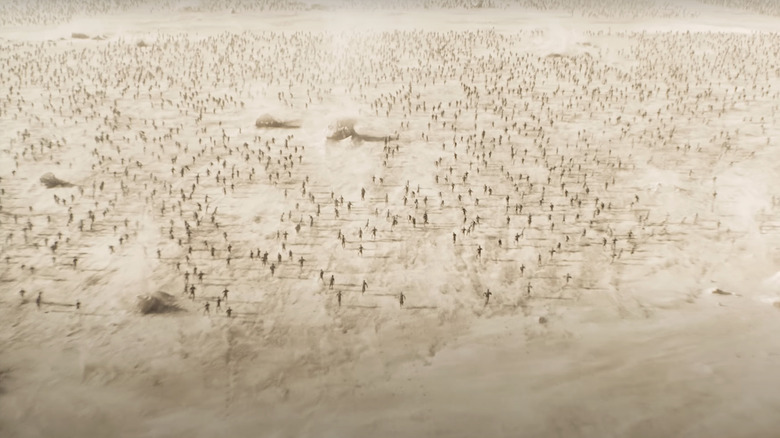Keeping Footprints Out Of Frame In Dune Was A Living 'Nightmare' For The Crew
Even if you weren't that big a fan of the bleak blockbuster that was "Dune: Part Two" or the equally bleak whisper-shout fest that was its 2021 predecessor "Dune," you've got to admire the artistry involved. If you take even a brief look at the effort that went into it, conceiving and creating the planet Arrakis was nothing short of an ordeal. Director Denis Villeneuve wasn't going to let "Dune" or its sequel become yet another generic CGI-laden blockbuster affair. Instead, he wanted to convey a real sense of texture and reality, even while bringing to life such fantastical source matter as Frank Herbert's 1965 novel.
There's a reason the visual effects team won an Oscar for the first "Dune." Not only did they manage to convincingly create scale, but they also managed to achieve Villeneuve's aim of making the film feel authentic despite the sheer amount of digital and practical effects work involved. Despite the two movies taking place on a desert planet with giant sandworms and incredibly advanced technology, both "Dune" and "Part Two" feel tactile in a way that many modern blockbusters simply don't. But creating that sense of realism wasn't easy.
While the visual effects team was busy inventing new techniques to depict some of the technology used by Timothée Chalamet's Paul Atreides, actually scouting locations for the desert planet Arrakis left Villeneuve and his crew "sand-traumatized." The director, cinematographer Greig Fraser, and production designer Patrice Vermette trekked across the deserts of Jordan and Abu Dhabi to find the ideal locations for their films, even down to specific sand dunes for certain scenes. But even after identifying the perfect spots, there were yet more issues to contend with.
Keeping footprints off the sand in Dune was 'a nightmare'
There's so much more than went into creating Denis Villeneuve's "Dune" movies. For instance, "Dune" avoided using greenscreen by building sets out of fabric so as to ensure the right light environment. Elsewhere, after locating the ideal sand dune for the intimate conversations between Paul Atreides and Zendaya's Chani, Greg Fraser was adamant that the crew could only shoot during the morning golden hour, to capture that reflective, somber tone. That meant some of the shortest scenes in "Dune: Part Two" took three entire days to shoot.
In a ScreenCrush interview, Villeneuve explained how important the ideal setting was to him, saying:
"That set that we choose, the sand dunes that are chosen ... we look like fools! Crazy people wandering in the desert, picking out specific sand dunes. Why? Because they have a certain shape that I want, or they have the perfect sun orientation that Greig [Fraser] needs."
You can imagine that if you'd spent huge amounts of time tracking down the perfect sand dunes for your sci-fi epic, you'd want to make sure the sweeping landscape wasn't perturbed in any way, right? Say, by footprints? But with such a massive production, keeping the dunes pristine was never going to be easy. Asked how minimized footprints, Villeneuve said:
"It is a nightmare. It's funny — it's not funny, but I remember Greig Fraser and I going 'Oh no, not again!' We have to instill a lot of discipline in our film crew. We have to make very tight corridors and try to protect our sand. So those sand dunes become very precious for us, and protected by a whole team. It requires a lot of discipline, because once you break one, it's done. So, yeah, it's like a puzzle."
There were several reasons to keep the sand clean in Dune
Keeping the sand undisturbed on "Dune" and "Dune: Part Two" wasn't just about making sure the scenes looked good. The amount of effort that went into finding the locations even went beyond finding sand dunes with the right shape. As Denis Villeneuve told Empire, production designer Patrice Vermette actually spent much of his time on the first film carrying bottles of sand around with him. This was due to the fact that the crew would frequently switch between the Liwa desert in Abu Dhabi and Jordan's Wadi Rum, so Vermette had to ensure the color and texture of the sand matched.
Even more amazing was the fact that, with "Part Two," Villeneuve and co. didn't repeat a single location from the first film, with the director saying, "We found completely fresh spots to tell our story this time around." So you can understand why the crew was so adamant about keeping the sand as pristine as possible.
With all that in mind, you have to hand it to Villeneuve and the crew. There is a reason why "Dune" and its sequel feel so tactile and realistic, and that's why the movies have succeeded in adapting what was supposedly an unadaptable book. We'll have to wait to see whether the director can keep up this level of meticulous filmmaking with the recently announced "Dune 3."


